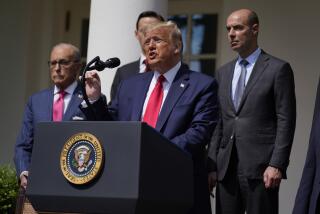Unions Confront Postelection Reality
- Share via
Before election day, AFL-CIO President John J. Sweeney called the prospect of a second term for President Bush “too horrible to think about.” Today, he and other shellshocked labor leaders will have no choice.
The federation’s executive council -- made up of presidents of the nation’s largest unions -- is set to convene in Washington for a postmortem on the presidential campaign and a discussion of possible reforms in the labor movement. And the six-hour meeting probably will be a somber affair.
Unions invested heavily in the Democratic presidential ticket, spending more than $100 million on voter mobilization efforts and sending tens of thousands of paid staff and volunteers to swing states in the final weeks of the race. They said it was a campaign they couldn’t afford to lose.
The next four years are “not going to be pretty” for organized labor, said Peter Dreier, a political science professor at Occidental College who closely follows labor. Among other things, the five-member National Labor Relations Board, which will soon have two openings, is pondering changes to case law that would make it more difficult for unions to organize new members.
Said Dreier, “The day-to-day work of trying to build the labor movement is going to be made much harder now.”
Not that it wasn’t hard before. Unions spent much of Bush’s first term fighting, and losing, defensive battles over worker safety rules, overtime pay, organizing rights and other issues.
In a postelection appearance Thursday, Sweeney noted that he had never met with President Bush, breaking a tradition of communication between presidents of both parties and the nation’s labor federation.
“Four years ago, we attempted to have a relation with the administration,” Sweeney said. “It’s public record what happened -- there was no relationship.”
When asked if he would try again, he said, “We’ll see what the next term brings.”
Before Nov. 2, union leaders dreamed of having an ally in John F. Kerry in the White House. They imagined an aggressive agenda that would include rolling back Bush administration changes to ergonomics rules and overtime protection and winning a substantial increase in the minimum wage.
Those goals seem far out of reach now. But several labor leaders said they were determined to move forward with their own union-specific initiatives.
“It’s time for the mourning to end,” said Bruce Raynor, general president of the Unite Here union. “Our job now is to get busy and plan.”
At the same time, today’s meeting is likely to kick off an intense and potentially divisive fight over the future of organized labor.
Lines have already been drawn, with fast-growing, aggressive unions such as the 1.7-million-member Service Employees International Union demanding that the labor movement consolidate much as corporate America has. The presidents of five unions have established the New Unity Partnership, which advocates a massive reduction in the number of unions -- from 63 to 15 -- with those remaining to be divided clearly along sectoral lines, such as hospitality and construction.
“We’ve got to make some changes,” said Raynor of Unite Here, recently created through the merger of the hotel workers and garment workers unions. “People want to win.”
That approach is too heavy-handed for some. “We have 116 years of making decisions for ourselves, and the idea that two or three folks are deciding there should only be 15 unions rubs the wrong way,” said Richard Sloan, communications director for the International Assn. of Machinists and Aerospace Workers, which is threatening to pull out of the federation if the partnership has its way.
The debate is expected to build up to July, when the AFL-CIO leadership stands for election. Sweeney said last year that he would seek another term, but there is widespread speculation that he will change his mind or be challenged.
Rumored successors include John Wilhelm of the hotel workers union, Andrew L. Stern of the service employees union and former mineworkers President Richard Trumka, who now holds the federation’s No. 2 position of secretary-treasurer.
At today’s meeting, national politics as well as union politics are on the agenda.
AFL-CIO Political Director Karen Ackerman will go over polling numbers showing that union households accounted for 24% of all votes cast Nov. 2. About 65% went to Kerry, with the rate slightly higher in Ohio, Pennsylvania and other states where unions focused their efforts.
The intense effort failed to raise the union vote share from what it was four years ago, but Ackerman said that was because Republicans ran their own effective ground campaign. More union voters cast ballots this year, she said, but so did everyone else.
Kate Bronfenbrenner, director of labor education research at Cornell University, said labor leaders could take credit for helping Kerry win in Michigan and Pennsylvania, where industrial unions have a strong presence. But they failed where unions haven’t organized on a large scale, mainly in the South, Southwest and mountain states.
Organizing in those vast stretches of political red should be a priority for unions, Bronfenbrenner said, even as they fight against attempts to limit the right to strike and organize.
“It’s going to be a lot harder,” she said, “but unions can do it if they capture the imagination, hopes and aspirations of working people.”
More to Read
Get the L.A. Times Politics newsletter
Deeply reported insights into legislation, politics and policy from Sacramento, Washington and beyond. In your inbox twice per week.
You may occasionally receive promotional content from the Los Angeles Times.










